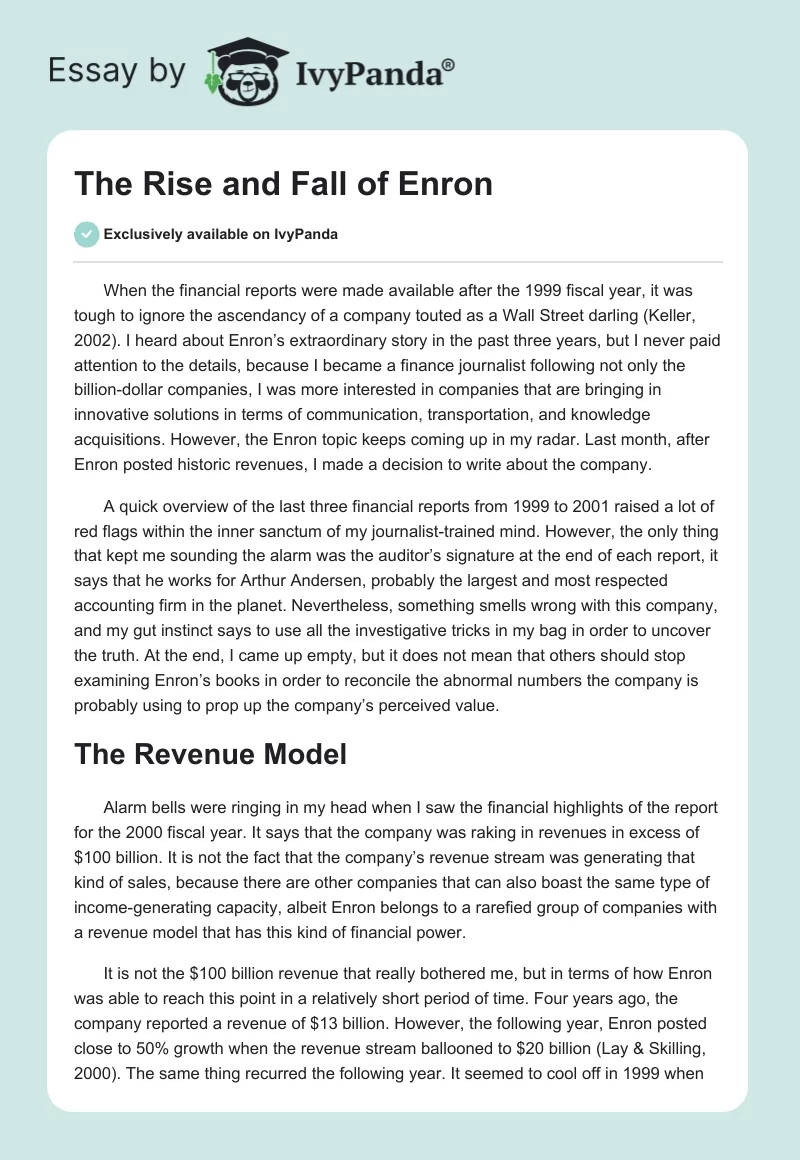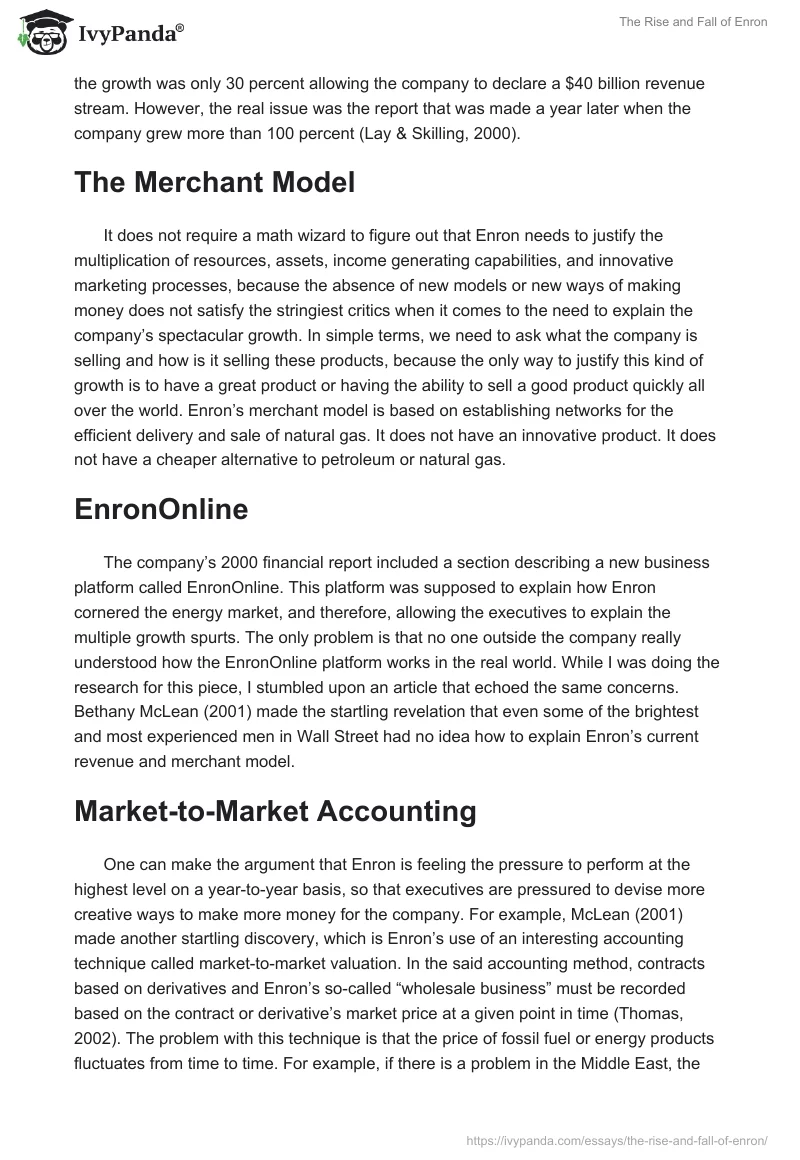When the financial reports were made available after the 1999 fiscal year, it was tough to ignore the ascendancy of a company touted as a Wall Street darling (Keller, 2002). I heard about Enron’s extraordinary story in the past three years, but I never paid attention to the details, because I became a finance journalist following not only the billion-dollar companies, I was more interested in companies that are bringing in innovative solutions in terms of communication, transportation, and knowledge acquisitions. However, the Enron topic keeps coming up in my radar. Last month, after Enron posted historic revenues, I made a decision to write about the company.
A quick overview of the last three financial reports from 1999 to 2001 raised a lot of red flags within the inner sanctum of my journalist-trained mind. However, the only thing that kept me sounding the alarm was the auditor’s signature at the end of each report, it says that he works for Arthur Andersen, probably the largest and most respected accounting firm in the planet. Nevertheless, something smells wrong with this company, and my gut instinct says to use all the investigative tricks in my bag in order to uncover the truth. At the end, I came up empty, but it does not mean that others should stop examining Enron’s books in order to reconcile the abnormal numbers the company is probably using to prop up the company’s perceived value.
The Revenue Model
Alarm bells were ringing in my head when I saw the financial highlights of the report for the 2000 fiscal year. It says that the company was raking in revenues in excess of $100 billion. It is not the fact that the company’s revenue stream was generating that kind of sales, because there are other companies that can also boast the same type of income-generating capacity, albeit Enron belongs to a rarefied group of companies with a revenue model that has this kind of financial power.
It is not the $100 billion revenue that really bothered me, but in terms of how Enron was able to reach this point in a relatively short period of time. Four years ago, the company reported a revenue of $13 billion. However, the following year, Enron posted close to 50% growth when the revenue stream ballooned to $20 billion (Lay & Skilling, 2000). The same thing recurred the following year. It seemed to cool off in 1999 when the growth was only 30 percent allowing the company to declare a $40 billion revenue stream. However, the real issue was the report that was made a year later when the company grew more than 100 percent (Lay & Skilling, 2000).
The Merchant Model
It does not require a math wizard to figure out that Enron needs to justify the multiplication of resources, assets, income generating capabilities, and innovative marketing processes, because the absence of new models or new ways of making money does not satisfy the stringiest critics when it comes to the need to explain the company’s spectacular growth. In simple terms, we need to ask what the company is selling and how is it selling these products, because the only way to justify this kind of growth is to have a great product or having the ability to sell a good product quickly all over the world. Enron’s merchant model is based on establishing networks for the efficient delivery and sale of natural gas. It does not have an innovative product. It does not have a cheaper alternative to petroleum or natural gas.
EnronOnline
The company’s 2000 financial report included a section describing a new business platform called EnronOnline. This platform was supposed to explain how Enron cornered the energy market, and therefore, allowing the executives to explain the multiple growth spurts. The only problem is that no one outside the company really understood how the EnronOnline platform works in the real world. While I was doing the research for this piece, I stumbled upon an article that echoed the same concerns. Bethany McLean (2001) made the startling revelation that even some of the brightest and most experienced men in Wall Street had no idea how to explain Enron’s current revenue and merchant model.
Market-to-Market Accounting
One can make the argument that Enron is feeling the pressure to perform at the highest level on a year-to-year basis, so that executives are pressured to devise more creative ways to make more money for the company. For example, McLean (2001) made another startling discovery, which is Enron’s use of an interesting accounting technique called market-to-market valuation. In the said accounting method, contracts based on derivatives and Enron’s so-called “wholesale business” must be recorded based on the contract or derivative’s market price at a given point in time (Thomas, 2002). The problem with this technique is that the price of fossil fuel or energy products fluctuates from time to time. For example, if there is a problem in the Middle East, the cost of petroleum skyrockets. In my opinion, the market-to-market scheme is a legal loophole that unscrupulous executives can use to increase the perceived value of a particular stock.
Analysis of Sustainable Cash Flow for 2000 and Commentary of Liquidity at the End of 2000
Enron executives are not fond of disclosures regarding the risks that they are taking in order to sustain a profitable run. For example, they do not highlight the fact that they need to spend or borrow a great deal of money to invest in unrelated business endeavors like broadband and transportation services. It is interesting to point out that Enron is piling up debts, the company’s debt-to-capital ratio is already up to 50% from 39% the previous year. If one combines this information with the revelation that the company’s cash flow was negative if not for the $400 million tax breaks, this leads to the suggestion that the company is not liquid as many have thought (Keller, 2002). If creditors are coming to collect today, I doubt if Enron has the cash to pay all its obligations.
Conclusion
There are so many red flags, and for me, the only thing that kept Enron’s boat afloat was the presence of a world-class accounting known all over the planet as Arthur Andersen. However, in other aspects, it is difficult to believe that the company has the capability to generate enough cash to fund its obligations in the short term. Thus, Enron executives are always talking about the future, because the current cash flow is perhaps telling a different story, a problem so big, it has the potential to destroy the hype of a $100 billion dollar company. I suggest caution in dealing with Enron.
References
Keller, B. (2002). Enron for dummies.The New York Times. Web.
Lay, K., & Skilling, J. (2000). Enron annual report 2000. Houston, TX: Enron.
McLean, B. (2001). Is Enron overpriced? Fortune. Web.
Thomas, C.W. (2002).The rise and fall of Enron. Web.


